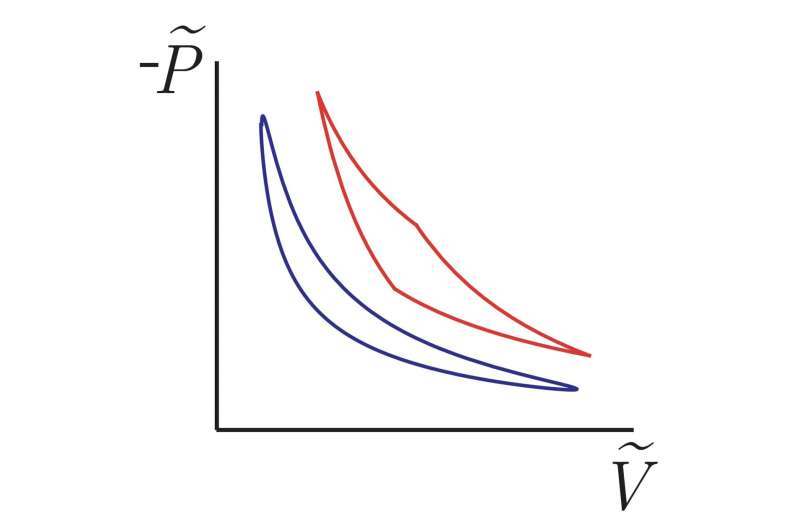July 8, 2022 feature
Using thermodynamic geometry to optimize microscopic finite-time heat engines

Stochastic thermodynamics is an emerging area of physics aimed at better understanding and interpreting thermodynamic concepts away from equilibrium. Over the past few years, findings in these fields have revolutionized the general understanding of different thermodynamic processes operating in finite time.
Adam Frim and Mike DeWeese, two researchers at the University of California, Berkeley (UC Berkeley), have recently carried out a theoretical study exploring the full space of thermodynamic cycles with a continuously changing bath temperature. Their results, presented in a paper published in Physical Review Letters, were obtained using geometric methods. Thermodynamic geometry is an approach to understanding the response of thermodynamic systems by means of studying the geometric space of control.
"For instance, for a gas in a piston, one coordinate in this space of control could correspond to the experimentally controlled volume of the gas and another to the temperature," DeWeese told Phys.org. "If an experimentalist were to turn those knobs, that plots out some trajectory in this thermodynamic space. What thermodynamic geometry does is assign to each curve a 'thermodynamic length' corresponding to the minimum possible dissipated energy of a given path."
Thermodynamic geometry allows researchers to examine interesting research questions, such as the optimal way to manipulate a given nanoscopic system, erase a bit of information, or build a classical or quantum heat engine.
"Our main objective in this paper was to figure out the most efficient way to run a microscopic engine so that it produces the most useful work for the amount of fuel it consumes," DeWeese told Phys.org. "Whereas most past thermodynamic geometry studies focused on optimizing the control of a system with a given initial and final settings, we were interested in constructing optimal closed curves that could function as highly efficient heat engines."
The main "rules" for understanding how to efficiently run large engines, such as those inside cars, when operated slowly, were first outlined over a century ago, when the laws of thermodynamics were first formulated. In their paper, Frim and DeWeese extended these theories so that they could also be applied to microscopic engines operating in finite time. In contrast with slowly operating large engines, these engines are not in thermal equilibrium with the external world and are strongly affected by thermal fluctuations in the surrounding environment.
"In any undergraduate thermodynamics course, we learn that if you plot pressure vs. volume of a gas in a cylinder and consider any closed cycle that returns to the same point on the graph, the area contained within the curve gives you the amount of useful work you get from one cycle of this heat engine," DeWeese said. "This assumes that you move very slowly around the cycle, so that the gas in the cylinder always remains close to equilibrium with the outside world. There is an analogy to this P-V diagram for microscopic engines, such as a small particle attached to a spring being buffeted by thermal fluctuations from its environment."
When they plotted cycles on the analog of a P-V diagram for a microscopic engine, Frim and DeWeese found that a particular function of the area contained inside the closed curve could still be thought of as the amount of useful work provided by one cycle of the engine. In addition, the length of the closed curve was found to be related to the amount of "useful work" that has been lost to dissipation (i.e., heating up the environment without going towards the engine's operation).
"Our result is relatively simple conceptually," DeWeese explained. "In thermodynamic geometry, length goes something like dissipation. So, we then thought: if you take a cycle (a closed loop) with some perimeter that has fixed length, what does the area inside this loop represent? As it turns out, it goes something like the work output of the cycle, so really, optimal cycles should have low dissipation and high output work, i.e., a small length and a large area."
Exploiting classical geometric results, the researchers were then able to identify optimal protocols that set a bound on the efficiency of all closed cycles. Their findings could significantly contribute to the design and development of efficient microscopic heat engines. The bound on the efficiency of irreversible thermodynamic cycles set by this team of researchers is general, thus its implications could reach far beyond the specific microscopic engines considered in their paper.
"One of our long-term goals is to develop the theory needed for engineers to design and build very small and efficient engines," DeWeese said. "This could turn out to be an important area of nanotechnology. We are also strongly motivated to understand the structure and function of the molecular motors and other types of molecular 'machines' that we see in the cells of all creatures and plants."
In their work, De Weese and Frim hypothesize that natural evolution might have selected for efficient molecular machines. If this were the case, the rules they discovered could be a first step towards being able to predict the structure and function of molecular machines that are ubiquitous in biology.
"Isoperimetric inequalities (that is, the interplay of lengths and areas of closed curves) in geometric approaches to physics could have myriad implications going forward," DeWeese added. "Our mathematical bound is more realistic than previous results that assumed the engine was very close to thermal equilibrium with the environment (or heat bath) at all times, but we do still assume that the system is being driven slowly (i.e., the control parameters are changed slowly). We are now interested in extending our results beyond this regime to include systems farther from equilibrium."
More information: Adam G. Frim et al, Geometric Bound on the Efficiency of Irreversible Thermodynamic Cycles, Physical Review Letters (2022). DOI: 10.1103/PhysRevLett.128.230601
Journal information: Physical Review Letters
© 2022 Science X Network





















